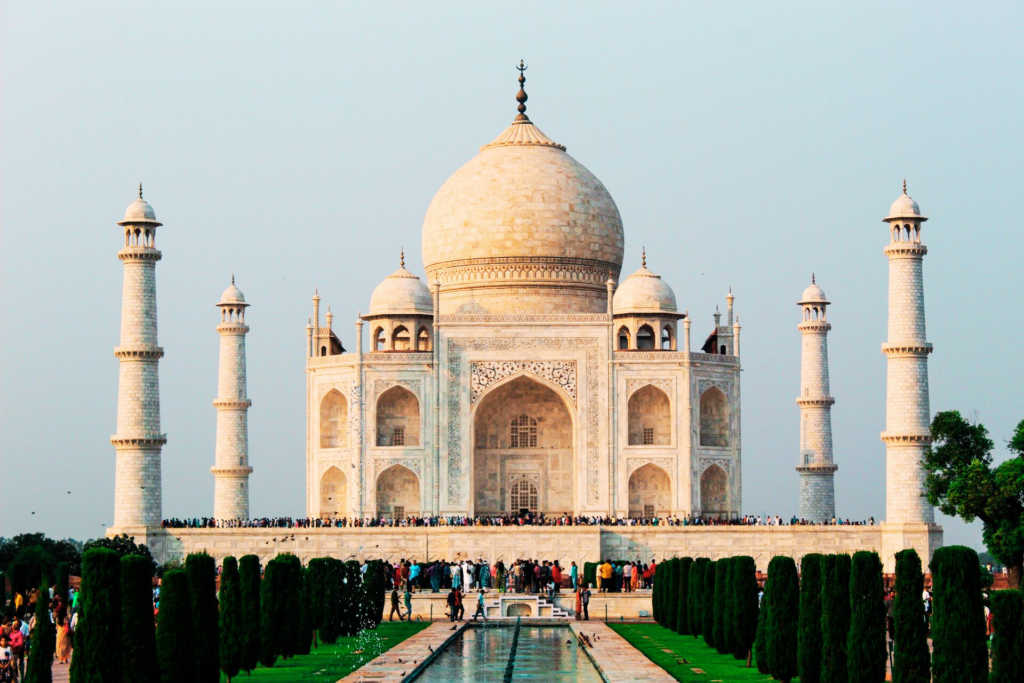The Tale of the Taj Mahal: A Monument of Love and Loss
Let me take you back to the 17th century, to the bustling courts of the Mughal Empire in India—a time of grandeur, poetry, and unmatched architectural marvels. Among these, one story stands out, etched forever in white marble: the story of the Taj Mahal.

A Love Born in the Emperor’s Court
In 1607, a young prince named Shah Jahan, known for his keen intellect and love for the arts, wandered through the royal marketplace. There, his eyes met Mumtaz Mahal, a Persian princess of exceptional beauty and grace. It was love at first sight.
Their union was not just a marriage; it was a meeting of two souls destined to be together. Mumtaz became Shah Jahan’s most trusted confidante, sharing his dreams and ambitions as he rose to the Mughal throne.
A Tragic Loss
In 1631, while accompanying Shah Jahan on a military campaign, Mumtaz Mahal passed away during childbirth, leaving the emperor heartbroken. Her last wish was that he build something magnificent to honour their love.
Consumed by grief, Shah Jahan vowed to fulfil her wish. What followed was one of the most extraordinary acts of devotion the world has ever seen—the creation of the Taj Mahal.
The Birth of a Masterpiece
Construction began in 1632 on the banks of the Yamuna River in Agra. Shah Jahan summoned the best architects, artisans, and craftsmen from across the empire and beyond—Persia, Turkey, and even Italy.
It took 22 years and over 20,000 workers to bring this vision to life. The Taj Mahal was designed to symbolize paradise on Earth, with its perfect symmetry, intricate carvings, and shimmering white marble.
The central dome, flanked by minarets, rose majestically, while delicate floral inlays of semi-precious stones adorned the walls. The reflecting pool mirrored its grandeur, creating an ethereal illusion of floating in the heavens.
A Symbol of Eternal Love
When the Taj Mahal was finally completed in 1653, it became a mausoleum not just for Mumtaz Mahal but for their enduring love. Shah Jahan himself spent hours gazing at it from the Agra Fort, where he was later imprisoned by his son Aurangzeb.
As the emperor’s final days approached, he expressed his desire to rest beside his beloved. His wish was granted, and today, Shah Jahan lies beside Mumtaz Mahal in the heart of the Taj Mahal, their story immortalized in stone.
The Taj Mahal Today
Centuries have passed, but the Taj Mahal remains a symbol of love, beauty, and devotion. It’s not just a monument; it’s a reminder that love can inspire creations that transcend time.
As you stand before it, bathed in the golden hues of sunrise or glowing under the moonlight, you can almost hear the whispers of Shah Jahan and Mumtaz Mahal—a love that will forever echo through the ages.
Would you visit this timeless wonder and feel the story etched in its walls?
FAQ about the Taj Mahal
1. Taj Mahal in which country
India
2. Why are 22 rooms locked in the Taj Mahal?
The 22 locked rooms in the Taj Mahal’s lower level are part of the structure’s sealed chambers, believed to support the monument’s foundation and manage humidity. They remain closed primarily for preservation and security, fueling myths and speculation about their contents.
3. What are 5 interesting facts about the Taj Mahal?
- The Taj Mahal changes colour during the day, appearing pinkish in the morning, white in the afternoon, and golden under moonlight.
- Emperor Shah Jahan built it in memory of his wife Mumtaz Mahal, taking 22 years to complete.
- Over 20,000 artisans worked on its construction, with materials sourced from across Asia.
- The four minarets are slightly tilted outward to protect the mausoleum in case of an earthquake.
- It is a UNESCO World Heritage Site and one of the World’s new Seven Wonders.
4. What is inside the Taj Mahal?
Inside the Taj Mahal lies the main mausoleum, housing the symbolic cenotaphs of Emperor Shah Jahan and his wife Mumtaz Mahal, intricately decorated with marble inlay and calligraphy. The actual graves rest in a lower chamber, following Islamic burial traditions.
5. Why Taj Mahal is called the symbol of love?
The Taj Mahal is called the “Symbol of Love” because it was built by Emperor Shah Jahan as a grand tribute to his beloved wife, Mumtaz Mahal, after her death. Its timeless beauty and emotional story reflect eternal love and devotion.
1 thought on “Taj Mahal”